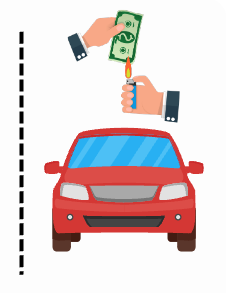Automobile Depreciation
The car depreciates by 15-25% each year during the first 5 years.
The car is worth about 40% of what you paid for it at the dealership.

Description
Before you sign the papers, make sure you understand how quickly your car’s value depreciates. Car depreciation refers to the gradual decrease in the value of your vehicle as time passes. Automobiles naturally decrease in value as time goes by, with various factors playing a role in determining the extent of depreciation. Elements such as the make a nd model, age, condition, mileage, ownership history, and even the color of the vehicle can impact its overall worth. Generally, new cars tend to experience more rapid depreciation compared to used ones. However, vigilant maintenance can help maintain a ve hicle's value for a longer period. You can utilize our car depreciation calculator to estimate the potential value of your car over a five year period.
How fast do cars depreciate per year?
There isn't a fixed rate for vehicle depreciation. In the initial year, a significant number of cars can lose up to 20% of their value, followed by an annual depreciation of around 15% until they reach the four or five year mark. On average, a new car loses 11% of its value the moment you leave the lot. During the first 5 years the car depreciates by 15% - 25% each year. After five years, the car is work 37% of what you paid for it at the dealership.
What factors affect car depreciation?
Consider these key factors when estimating your vehicle's value:
Make and Model:
Vehicles from popular makes and models tend to maintain their value for a longer period compared to less popular ones.
Condition:
Vehicles with typical wear and tear tend to retain their value better than those involved in accidents or used for heavy duty-work. For example, a truck used for off-road purposes will likely experience more wear and tear compared to a car used for daily commuting.
Age:
Generally, as a vehicle gets older, its value decreases, although there are exceptions, such as classic cars, which can appreciate in value over time.
Mileage:
Vehicles have a practical limit on the number of miles they can accumulate before requiring significant, costly repairs. Higher mileage often correlates with lower resale value.
Other factors, including ownership history and even the vehicle's color, can occasionally influence depreciation. A custom paint job, for instance, might lead to more significant depreciation compared to a car with a standard black or grey paint job.
How can I limit my car’s depreciation?
To mitigate your car's depreciation, while you can't entirely prevent it, you can adopt these strategies to limit the loss in value:
Control Mileage:
Try to keep your annual mileage under 10,000 miles. Lower mileage not only keeps the odometer reading low but also reduces the chances of accidents and wear and tear.
Covered spot or garage:
Keep your car in a garage or a covered spot whenever possible. This protection shields your vehicle from the elements, preserving its paint job and safeguarding it against severe weather damage, such as hail.
Routine Maintenance:
Adhere to the manufacturer's recommended maintenance schedule. Regularly scheduled oil changes, tire rotations, and other upkeep tasks are crucial. Neglecting engine maintenance can significantly impact your vehicle's value, particularly if it's a sought-after model with buyers seeking all original parts.